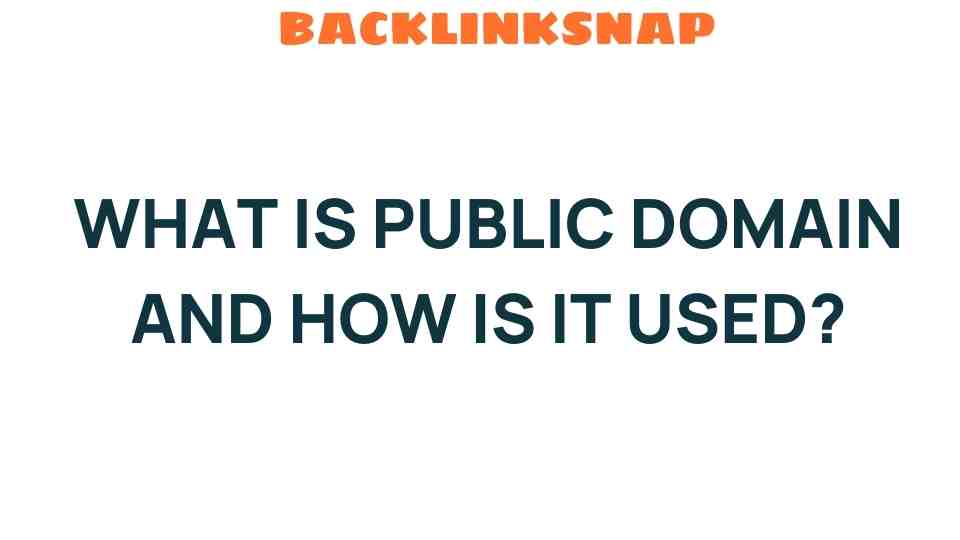Unlocking the Secrets of Public Domain: What It Is and Its Uses
In the realm of intellectual property, the term public domain often sparks curiosity and debate. But what exactly does it entail? Simply put, public domain refers to creative works—be it literature, art, music, or scientific research—that are not protected by copyright. This means that anyone can use, share, and modify these works without seeking permission or paying royalties. Understanding public domain is vital not just for artists and creators but also for anyone who values access to knowledge and cultural heritage.
The Legal Framework Behind Public Domain
The concept of public domain is deeply rooted in copyright law, which serves to balance the interests of creators and the public. Copyright protects original works for a limited time, allowing creators to benefit from their labor. However, once that time elapses, the work enters the public domain. The specifics of this transition depend on various factors, including the date of creation and the jurisdiction in which the work was created.
- Works Created Before 1923: As of now, all works published before 1923 are in the public domain in the United States.
- Life of the Author Plus 70 Years: For works created after 1978, copyright lasts for the life of the author plus 70 years.
- Corporate Authorship: Works created by corporations typically have a shorter copyright lifespan, usually 95 years from publication.
This legal framework ensures that after a certain period, the intellectual property becomes a shared resource, contributing to the collective cultural heritage of society.
Why Public Domain Matters
Public domain plays a crucial role in fostering creativity and innovation. By removing restrictions on the use of creative works, it enables individuals to build upon existing ideas, leading to new interpretations, adaptations, and innovations. Here’s why public domain matters:
- Access to Free Resources: Public domain works serve as invaluable resources for educators, researchers, and creatives. From Shakespeare’s plays to classic films, these works are available for anyone to use without cost.
- Cultural Heritage: Public domain preserves the cultural heritage of humanity. It ensures that key historical texts, artworks, and scientific discoveries remain accessible to everyone, enriching our understanding of the past.
- Encouraging New Creations: Artists and creators can draw inspiration from public domain works to create new masterpieces. This cross-pollination of ideas often leads to groundbreaking innovation.
How to Identify Public Domain Works
Identifying what is in the public domain can be straightforward if you know what to look for. Here are a few tips:
- Check the Publication Date: As mentioned earlier, works published before 1923 are public domain in the U.S.
- Look for Expired Copyrights: Use resources like the U.S. Copyright Office to determine if a work’s copyright has expired.
- Use Reputable Databases: Websites like Project Gutenberg and Internet Archive offer vast collections of public domain texts and media.
Having access to these resources can open up a wealth of opportunities for both personal and professional projects.
Creative Uses of Public Domain Works
Now that we’ve covered what public domain is and why it matters, let’s explore some creative ways people are utilizing these resources:
- Remixing and Adaptation: Musicians often sample public domain music to create new songs, while filmmakers adapt classic literature into modern films.
- Educational Use: Teachers utilize public domain texts to create lesson plans and teaching materials, ensuring that students have access to quality resources.
- Art Projects: Artists can use public domain images as a base for their own creations, allowing them to experiment with styles and techniques.
These applications illustrate how public domain fuels creativity and enhances the educational landscape.
Challenges and Misconceptions
Despite its benefits, public domain is often misunderstood. Some common misconceptions include:
- All Old Works are Public Domain: Not all older works are public domain; copyright laws vary by country and may apply differently to certain types of works.
- Public Domain Means No Quality Control: Just because a work is in the public domain doesn’t mean it’s of low quality. Many cherished classics are freely accessible.
Being aware of these misconceptions can help individuals make informed decisions about using public domain works.
FAQs about Public Domain
1. What is public domain?
Public domain refers to creative works that are free from copyright restrictions, allowing anyone to use, share, and modify them without permission.
2. How can I find public domain works?
You can find public domain works through various resources, including Project Gutenberg, the Internet Archive, and the U.S. Copyright Office.
3. Are all old works in the public domain?
No, not all old works are in the public domain. The copyright status of a work depends on its publication date and other factors.
4. Can I adapt a public domain work?
Yes! You can freely adapt, remix, or build upon public domain works without seeking permission.
5. What happens when a copyright expires?
When a copyright expires, the work enters the public domain and can be used by anyone without restrictions.
6. Is public domain the same as Creative Commons?
No, public domain means there are no copyright restrictions at all, while Creative Commons licenses allow creators to retain some rights while permitting certain uses of their work.
Conclusion
Understanding the concept of public domain is essential for anyone interested in the creative landscape. It not only offers a treasure trove of free resources and cultural heritage but also empowers individuals to innovate and create anew. By unlocking the secrets of public domain, we can foster a more inclusive and collaborative environment that celebrates creativity and knowledge. With the right legal framework in place, the possibilities for utilizing these creative works are endless, opening doors to a future rich with inspiration and growth.
For further information, feel free to explore The Public Domain Review, a platform dedicated to showcasing public domain works and their cultural significance.
This article is in the category Digital Marketing and created by BacklinkSnap Team




